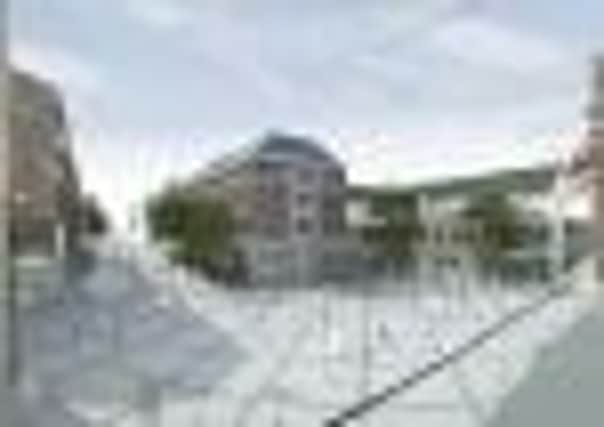New central role planned for a Leeds monument to Methodism


The former Victorian church could be turned into a top-class restaurant as part of a £600m plan to make Leeds a more attractive place to work and shop.
Developers Hammerson, who are behind the retail-led Eastgate development, want to make Templar House the central feature of a new square.
Advertisement
Hide AdAdvertisement
Hide AdAndrew Hilston, the project director of Eastgate, said Templar House could emulate the success of a similar building on a Hammerson development in Bristol, which was turned into a Raymond Blanc restaurant.
Mr Hilston said the square “will be a multi-purpose place” with top-class shops and places to eat.
The Eastgate scheme, which is being considered by Leeds City Council, will transform the 6.9 hectare brownfield site.
Most the area has been empty since the 1970s.
Plans for the Eastgate scheme include a two-level shopping arcade, a new civic square, the largest shopper car park in the city and offices.
Advertisement
Hide AdAdvertisement
Hide AdIt will have about 130 stores, anchored by John Lewis and Marks & Spencer.
Hammerson believes the scheme will create 4,000 jobs and, if Eastgate gains planning permission, it could be completed by 2015.
Mr Hilston told the Yorkshire Post that a number of recurring themes had emerged during the public consultation about Eastgate.
“People were asking, ‘Why isn’t John Lewis already in Leeds?’
Advertisement
Hide AdAdvertisement
Hide Ad“They wanted to know why Leeds doesn’t have more flagship stores like Manchester. It’s just that the right environment hasn’t been created yet.”
Templar House has had a chequered history.
It was lucky to escape demolition during the upheavals of the 20th century.
The Grade II listed building, dates from 1840, and was originally built as Yorkshire’s main chapel for the Wesleyan Methodist Association.
Some of the early worshippers might have known John Wesley (1703-1791), who was a regular visitor to Yorkshire during his marathon preaching trips around Britain.
Advertisement
Hide AdAdvertisement
Hide AdThe Wesleyan Methodist Church was the name used by the major Methodist movement in Great Britain following its split from the Church of England after Wesley’s death.
In its heyday, the chapel held 1,700 worshippers, with a schoolroom underneath for 400 pupils.
Designed by the local architect, James Simpson, Templar House became one of the biggest chapels of its kind in Yorkshire.
Sadly, the world around it changed during the last century.
As a Hammerson spokesman observed the “removal of the surrounding urban fabric” left it isolated and it stopped acting as a chapel in the early 1930s. It was converted into offices in 1933.
Advertisement
Hide AdAdvertisement
Hide AdAs part of the Eastgate development, Hammerson is proposing to repair and refurbish Templar House.
A Hammerson spokesman added: “It’s repositioning to become the central feature of the newly created Eastgate Square, will give the building its due prominence within the Eastgate Quarters and re-connect the city with one of its hidden jewels.
“Overall, it has a fairly plain but not severe architecture, which is typical of the worthy and energetic Methodism of the 1840s.
“This architecture can still be distinguished under the mess of later alterations and dereliction.”
Advertisement
Hide AdAdvertisement
Hide AdPlans for a Low Carbon Energy Centre have also been submitted as part of the revised Eastgate Quarters scheme.
The LCEC, which will be based on Bridge Street, aims to generate the sustainable, low carbon heating, cooling and power which is required by the scheme and neighbouring homes and businesses.
Designed by ACME, it would enable buildings to connect to a community heating and power network, which will be compatible with many forms of renewable energy.
Heat and energy generated in the process will be fed back to provide heating and cooling for neighbouring developments.
Advertisement
Hide AdAdvertisement
Hide AdThis heat will be supplemented by additional on-site production using biomass and renewable fuels.
Hammerson said it could reduce carbon emissions for the development and surrounding area by 25-30 per cent.
Mr Hilston said Hammerson had received “strong feedback” on the revised proposals.
He believed it had resulted in a “best in class” masterplan.
Advertisement
Hide AdAdvertisement
Hide AdSome traders and shoppers have expressed concern that the Eastgate scheme could have a detrimental impact on the neighbouring Kirkgate market.
However, Mr Hilston said that he had received “very positive comments from people involved in the market”.
He added: “I can’t see that Eastgate can be anything but good for Kirkgate Market.
“We want to transform a derelict area and bring in hundreds of thousands of shoppers.”
A history of Hammerson
Advertisement
Hide AdAdvertisement
Hide AdHammerson. the company behind the proposed Eastgate scheme in Leeds, has been creating and managing retail sites and office buildings in Europe for more than 60 years.
The company’s website says: “We focus on prime regional shopping centres and out-of-town retail, while exploiting opportunities in the office sector. Our strategy is to outperform through two areas of focus: income growth and high quality property, both of which are underpinned by our capital strength.”